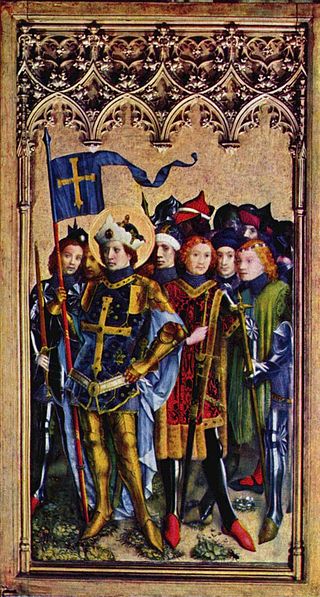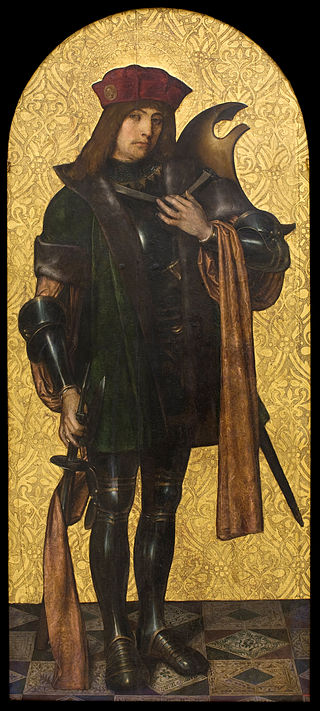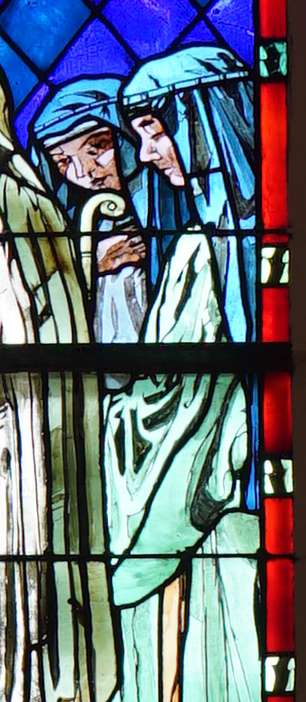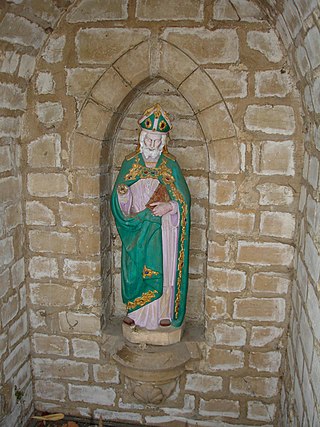
Germain was the bishop of Paris and is venerated as a saint in both the Catholic Church and the Eastern Orthodox Church. According to an early biography, he was known as Germain d'Autun, rendered in modern times as the "Father of the Poor".

Sigebert III was the Merovingian king of Austrasia from 633 to his death around 656. He was described as the first Merovingian roi fainéant —do-nothing king—, in effect the mayor of the palace ruling the kingdom throughout his reign. However he lived a pious Christian life and was later sanctified, being remembered as Saint Sigebert of Austrasia in the Roman Catholic Church and Eastern Orthodox Church.

The Theban Legion figures in Christian hagiography as a Roman legion from Egypt —"six thousand six hundred and sixty-six men" — consisting of Christian soldiers who were martyred together in 286, according to the hagiographies of Maurice, the chief among the Legion's saints. Their feast day is held on September 22.
Agaunum was an outpost in Roman Switzerland, predecessor of the modern city of Saint-Maurice in the canton of Valais, southwestern Switzerland. It was used by the Roman Empire for the collection of the Quadragesima Galliarum. In Christian tradition, Agaunum is known as the place of martyrdom of the Theban Legion.

September 21 - Eastern Orthodox liturgical calendar - September 23

Sigebert or Sigibert of Gembloux was a medieval author, known mainly as a pro-Imperial historian of a universal chronicle, opposed to the expansive papacy of Gregory VII and Pascal II. Early in his life he became a monk in the Benedictine abbey of Gembloux.
Finan of Lindisfarne, also known as Saint Finan, was an Irish monk, trained at Iona Abbey in Scotland, who became the second bishop of Lindisfarne from 651 until 661.

Gembloux Abbey was a Benedictine abbey near Gembloux in the province of Namur, Wallonia, Belgium. Since 1860, its buildings host the University of Liège's Gembloux Agro-Bio Tech faculty and campus.

The Abbey of Saint Maurice, Agaunum is a Swiss monastery of canons regular in Saint-Maurice, Canton of Valais, which dates from the 6th century. It is situated against a cliff in a section of the road between Geneva and the Simplon Pass. The abbey itself is a territorial abbacy and not part of any diocese. It is best known for its connection to the martyrdom of the Theban Legion, its original practice of perpetual psalmody, and a collection of art and antiquity.

Candidus was a commander of the Theban Legion. The Theban Legion was composed of Christians from Upper Egypt. He is venerated as a Christian saint and martyr.

Maurice was an Egyptian military leader who headed the legendary Theban Legion of Rome in the 3rd century, and is one of the favourite and most widely venerated saints of that martyred group. He is the patron saint of several professions, locales, and kingdoms.

Saint Dode was an Abbess of Saint Pierre de Reims and a French Saint whose Feast Day is 24 April. She is reputed to be the daughter of Chloderic, King of the Ripuarian Franks and the sister of Munderic, making her a princess of the Ripuarian Franks.

Praejectus, Prejectus or Projectus (625–676) was a bishop of Clermont, who was killed together with the abbot Amarinus as a result of contemporary political struggles.
Saints Felinus and Gratian(us) (sometimes Gratinian(us)) (d. 250 AD) are venerated as martyrs by the Catholic and Eastern Orthodox churches. They are patron saints of Arona, near Milan, where their relics were enshrined.

Saint Antoninus of Pamiers was an early Christian missionary and martyr, called the "Apostle of the Rouergue". His life is dated to the first, second, fourth, and fifth century by various sources since he is often confused with various other venerated Antonini. Today he is revered as the patron saint of Pamiers, Palencia, and Medina del Campo. His historicity and exact identity are in doubt.

Magnus of Cuneo is venerated as a martyr and member of the legendary Theban Legion. The center of his cult is situated at the mountain sanctuary known as the Santuario di San Magno, in the Valle Grana, Castelmagno, in the province of Cuneo. His feast day is August 19.
Anselm of Gembloux, Latinized Anselmus Gemblacensis was abbot of Gembloux Abbey 1115–1136, and continuator of the chronicle of Sigebert of Gembloux.

Verena of Zurzach, also known as Saint Verena was an early Christian consecrated virgin and hermit. She is venerated as a saint in the Eastern Orthodox Church, Roman Catholic Church and Oriental Orthodox Churches. She is especially venerated in Switzerland, where her cult is attested in Bad Zurzach, the reported place of her burial, from at least the 5th century. Her feast is on 1 September.
Saint Guibert of Gorze is the founder of Gembloux Abbey, in Gembloux. He was canonized in 1211. Saint Guibert's Day is observed on 23 May.
Erluin was a Benedictine monk, the first abbot of Gembloux (946–87) and also briefly the abbot of Lobbes (956–57). Diametrically opposed accounts of his character are given by the partisans of Gembloux and Lobbes.












